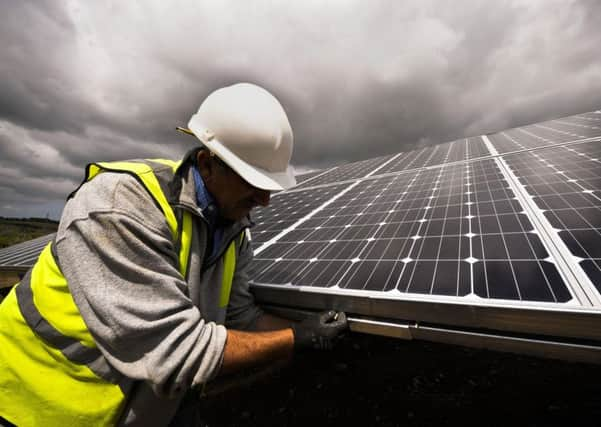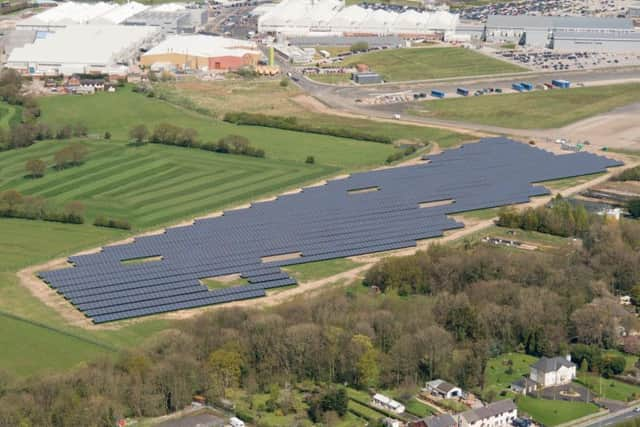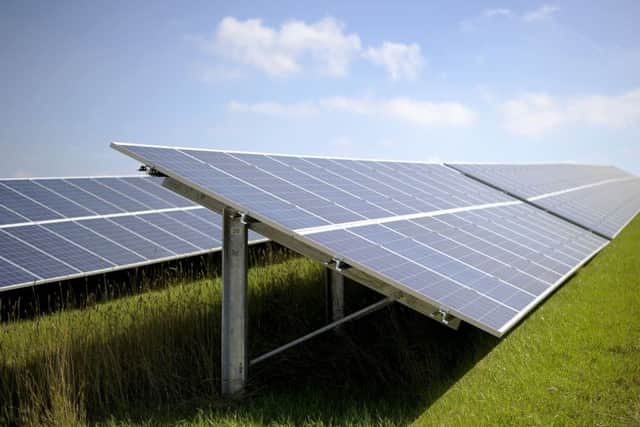Future looks bright as solar energy is on rise


The Government has withdrawn or cut many subsidies for solar panels, leaving the UK solar industry is a crisis and prompting claims of thousands of jobs lost.
But many people and businesses have invested in panels on their roofs to do their bit for greenhouse gas reduction, or to become electricity independent and save money.
Advertisement
Hide AdAdvertisement
Hide AdNetwork Rail, which is electrifying rail around the UK including between Preston and Blackpool, has said it was looking into using trackside solar panels to provide the elecricity for its third rail to power electric trains in the future.


Solar photovoltaics are panels that convert the rays of the sun into energy. Energy UK says current installed capacity exceeds 8.7GW and is increasing rapidly, with year-on-year growth exceeding 80 per cent in 2015.
In 2016 the UK got three per cent of its electricity from solar - around 10 Terra Watt Hours. That had grown from just half a per cent in 2013 and it is estimated that there are more than 54,000 solar PV sites in the North West.
Locally, companies such as Glasdon at Preston New Road, Blackpool, has installed 120 solar PV panels on its roof which were due to make 21,660 KWh of electricity in its first year.
Advertisement
Hide AdAdvertisement
Hide AdHot water storage vessels maker Gledhills in Squires Gate, Blackpool, also installed solar PV panels on its roof.


It is not just security of energy supply that interests businesses, but also ways of saving money on energy bills and even reducing a company’s carbon footprint.
One way of doing this is by using the building and real estate to generate its own energy through renewables and by making energy efficiency improvements to cut costs.
BAE Systems has the muscle to do this and has been able to introduce a number of ideas at its sites in Lancashire and across the UK. At Samlesbury, it has built a solar panels array which generates two gigawatts a year - enough energy to power a third of the site, or the equivalent of powering 300 family homes.
Advertisement
Hide AdAdvertisement
Hide AdThe 9,000 solar panels at the farm built on part of the disused runway, saves £300,000 and cuts the amount of CO2 generated by production at the site by 900 tons a year.


Mark Tooth, sustainability manager for BAE Systems Military Air and Information, said the company takes seriously its commitment to reducing climate change and submits an annual report on energy savings and CO2 emissions.
He said: “The investment in the large scale solar farm has reduced our carbon footprint and operations costs. It’s a virtual circle.
“In its first full year it actually performed better than expected and slightly exceeded our expectations.”
Advertisement
Hide AdAdvertisement
Hide AdHe said even in rainy Lancashire, the amount of sunshine falling on the panels still generated a significant saving.


“We have good days and bad days, but that was all factored in when we were doing projections for the scheme.
“It does not produce as much electricity in the winter obviously because the sun is further away and lower in the sky but over the year, it is very successful.”
He said the array was state of the art typical of large scale solar PV arrays and was expected to be still running after 20 years and predicted that the costs of similar scheme would fall in the future as manufacturing costs fall, improvements area made to their efficiency and political will changes.
Advertisement
Hide AdAdvertisement
Hide AdHe said many businesses would be looking at using renewables for cutting costs and carbon footprint in the future.
There were examples across the county now including wind power turbines at such places a Dewlay Cheese near Garstang and at Lancaster University.
But he said wind was not an easy solution for a company building aircraft since turbines would cause issues with air traffic safety near runways.
Mark added the biggest saving the company has been making is with energy efficiency improvement schemes within the buildings the company owns.
Advertisement
Hide AdAdvertisement
Hide AdThe company is on record as saying cutting energy makes good business sense as energy costs rise and energy efficiency is increasingly important to its customers such as the Ministry of Defnece and the Australian Defence Force which are obliged to become more sustainable under international commitments.
BAE System’s Samlesbury site has developed an innovative ‘energy loop’ that connects the site’s heating and cooling systems and is expected to save over £2M over the next 10 years thanks to reduced energy costs.
The system captures waste energy from manufacturing machines and uses it to heat other areas of the facility such as offices and staff amenities. An initial trial produced 0.5 megawatts of heat (enough to heat 60 houses) using just five per cent of the energy used by the previous heating system.
Also at Samlesbury, a new employee restaurant and wellbeing facility is set to be the greenest building at BAE Systems, using a variety of green measures to minimise its impact on the environment, from maximising the use of natural light to using solar panels to generate electricity and heat.
Advertisement
Hide AdAdvertisement
Hide AdAn environmental survey at MA&I’s aircraft testing facility in Warton identified savings equivalent to 800 tonnes of CO2 per year by using plant more efficiently. Around 31 acres of BAE Systems’ Bridgwater site are being leased to a renewable energy company for use as a solar park to generate solar power.
The land will generate up to 4.22 megawatts of solar power that will be used to power part of the adjoining BAE Systems site and ultimately feed into the National Grid.
At Warton, small scale solar water schemes are used to pre-heat domestic water supplies.
And finally the company’s gas and electric meters monitor usage every 30 minutes to help target wastage.